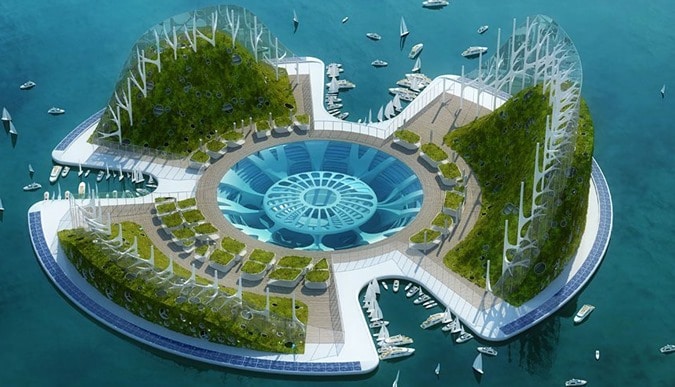Artificial Island Construction Methods, Design and Advantages
Artificial Island is an artificially man-made structure that has not formed naturally. This type of islands can be constructed anywhere, any size and shape and can be used for infrastructure, tourism and industry purpose.
History of Artificial Island
Artificial Island may have become popular and seen as a modern technique but its history dates back long time behind. It was even used in Ancient Egyptian Civilization.
In 17th century it has been extensively used for Oil exploration and production platforms, coal mine ventilation, coastal defense and extensive of land base. Japan has constructed many artificial Island around it counting to 1000 sq.km.
Nowadays technology so vastly developed that construction of artificial islands in water depth of 75 meter are also possible.

Need for Construction of Artificial Island
The need for construction of artificial island has increased in the recent days as any naturally formed land surface is not available in the desired places for the following requirements:
- Extended airport runways
- Wind energy generation in seas and ocean
- Underwater mining of mineral resources
- Oil and petroleum drilling platforms
- Tourism and recreational success like hotel and parks
- Infrastructure development of ports and airports
Factors to be Considered for Design of Artificial Island
Following factors influence the design and construction of artificial islands:
- The depth of water is the first and foremost factor that influences on the design of artificial Island. More the depth more complicated is design and execution.
- The height of the waves that hit on the structure.
- Currents of the ocean.
- Top construction material available in the nearby vicinity.
- Existing pipelines or cables.
- Environmental conservation and Flora Fauna in that region.
- Foundation conditions and earthquake risk.
Types of Load Imposed on Artificial Island
Many types of loads are to be considered while designing artificial Island. They are as follows,
1. Permanent or dead load
This type of loads includes the weight of structure and superstructure coming up on it, machineries and equipments that are permanently fixed hydrostatic pressure and buoyance in sea level, ballast water pressure and earth pressure.
2. Variable or live load
Loads such as machineries, materials that are placed on the island at the time of construction. Pressure exerted on the structure internally and externally from water, wind and other factors. The load due to movement of vehicles or machinery on structures like helicopter, vessels, cranes and dredging machines.
3. Environmental Loads
Natural loads like wind pressure, climatic changes, wave and tidal loads, ocean currents and earthquake loads are to be considered while designing of artificial Island.
Process of Artificial Island Construction
The construction process of an artificial Island is as follows,
1) Dredging
Dredging is the process of removal of top lose layer of the water bed to create harbors, channels, docks, de-silting lakes or deepening waterways. It is also termed as Maritime transportation.
A special type of machine is used for dredging known as dredger. Different types of methods used for dredging depends upon the following factors:
- Dredging depth
- Kind of soil
- Type of operational area
- Water depth
- Density hardness strength and grain size of soil
- Degree of automation used and many more
2) Bed Preparation for Artificial Island
The preparation of a strong and hard bed on the water strata is prominent step in construction of artificial Island. After the dredging of top loose soil is done and hard strata is found, the following process takes place:
- As mentioned above the source of material is critical in selection of islands site. If the material is far, the cost increases drastically.
- A good quality coarse grain sand is ideal for bed preparation.
- This sand is directly dump into dredged construction site from the trailer.
- When the water becomes shallow the sand is transported with the help of stationary dredger to the required places.
- The sand is protected from water waves by rack revetments and layer of armor rocks.
- On the top surface of sand, bitumen emulsion is sprayed followed by layer of soil.
- To reduce soil erosion suitable grass is planted on the embankments.
3) Concreting
The following steps are involved in concreting processes for construction of artificial island.
- Temporary tube piles, sheet piles and tie rods are driven in to the sea bed.so as to support the boundary rocks.
- Boundary rock bunds are placed on the either sides of the sheet piles.
- Between the rock bunds, hydraulic fill is deposited to remove seawater and form an island.
- Concrete armor unit are placed permanently all around the island to protect it from waves.
- Now piles are driven to sea bed to stabilize the structure.
- Inside part of the island is evacuated and cofferdam is installed.
- Thick concrete slab is laid down at the base.
- Reinforce concrete retaining wall is built around the island.
Advantage and Disadvantages of Artificial Island
Advantages of Artificial Island
- Any shape, any size & anywhere.
- Land reclamation will definitely increase land area for a certain country.
- More lands, more buildings and better infrastructure can be built.
- Can reclaimed lot of lands from flooding.
- Can be used for mass tourism as Palm Islands, Dubai.
Disadvantages of Artificial Island
- As the process is very costly this can lead to financial crisis.
- Slow construction process due to limited availability of dredgers.
- Faulty construction process can cause settlement of the island in deep waters, as in the case of Kansai Airport, Japan.
- Land reclamation can be damaging to corals and marine life.
- Excessive exposure to winds, tidal forces and earthquake and tsunami loads hence special provisions required.
Comments